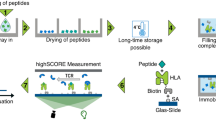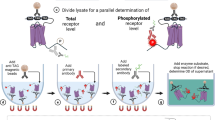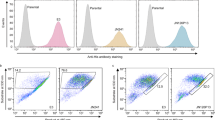Abstract
The formylpeptide receptor (FPR) family of G protein–coupled receptors contributes to the localization and activation of tissue-damaging leukocytes at sites of chronic inflammation. Here we describe a high-throughput flow cytometry screening approach that has successfully identified multiple families of previously unknown FPR ligands. The assay detects active structures that block the binding of a fluorescent ligand to membrane FPR of intact cells, thus detecting both agonists and antagonists. It is homogeneous in that assay reagents are added in sequence and the wells are subsequently analyzed without intervening wash steps. Microplate wells are routinely processed at a rate of 40 wells per minute, requiring a volume of only 2 μl to be sampled from each. This screening approach has recently been extended to identify a high-affinity, selective agonist for the intracellular estrogen-binding G protein–coupled receptor GPR30. With the development of appropriate assay reagents, it may be generally adaptable to a wide range of receptors. The total time required for the assay ranges between 1.5 and 2.5 h. The time required for flow cytometry analysis of a 96-well plate at the end of the procedure is less than 2.5 min. By comparison, manual processing of 96 samples will typically require 40–50 min, and a fast commercial automated sampler processes 96-well plates in less than 15 min, requiring the aspiration of 22 μl per sample for an analysis volume of 2 μl.
This is a preview of subscription content, access via your institution
Access options
Subscribe to this journal
Receive 12 print issues and online access
$259.00 per year
only $21.58 per issue
Buy this article
- Purchase on Springer Link
- Instant access to full article PDF
Prices may be subject to local taxes which are calculated during checkout



Similar content being viewed by others
References
Sklar, L.A., Edwards, B.S., Graves, S.W., Nolan, J.P. & Prossnitz, E.R. Flow cytometric analysis of ligand-receptor interactions and molecular assemblies. Annu. Rev. Biophys. Biomol. Struct. 31, 97–119 (2002).
Kuckuck, F.W., Edwards, B.S. & Sklar, L.A. High throughput flow cytometry. Cytometry 44, 83–90 (2001).
Ramirez, S., Aiken, C.T., Andrzejewski, B., Sklar, L.A. & Edwards, B.S. High-throughput flow cytometry: Validation in microvolume bioassays. Cytometry 53A, 55–65 (2003).
Le, Y., Murphy, P.M. & Wang, J.M. Formyl-peptide receptors revisited. Trends Immunol. 23, 541–548 (2002).
Oppenheim, J.J., Zachariae, C.O., Mukaida, N. & Matsushima, K. Properties of the novel proinflammatory supergene “intercrine” cytokine family. Annu. Rev. Immunol. 9, 617–648 (1991).
Schiffmann, E. et al. The isolation and partial characterization of neutrophil chemotactic factors from Escherichia coli. J. Immunol. 114, 1831–1837 (1975).
Schiffmann, E., Corcoran, B.A. & Wahl, S.M. N-formylmethionyl peptides as chemoattractants for leucocytes. Proc. Natl. Acad. Sci. USA 72, 1059–1062 (1975).
Marasco, W.A. et al. Purification and identification of formyl-methionyl-leucyl-phenylalanine as the major peptide neutrophil chemotactic factor produced by Escherichia coli. J. Biol. Chem. 259, 5430–5439 (1984).
Carp, H. Mitochondrial N-formylmethionyl proteins as chemoattractants for neutrophils. J. Exp. Med. 155, 264–275 (1982).
Walther, A., Riehemann, K. & Gerke, V. A novel ligand of the formyl peptide receptor: annexin I regulates neutrophil extravasation by interacting with the FPR. Mol. Cell 5, 831–840 (2000).
Su, S.B. et al. T21/DP107, A synthetic leucine zipper-like domain of the HIV-1 envelope gp41, attracts and activates human phagocytes by using G-protein-coupled formyl peptide receptors. J. Immunol. 162, 5924–5930 (1999).
Le, Y. et al. N36, a synthetic N-terminal heptad repeat domain of the HIV-1 envelope protein gp41, is an activator of human phagocytes. Clin. Immunol. 96, 236–242 (2000).
VanCompernolle, S.E., Clark, K.L., Rummel, K.A. & Todd, S.C. Expression and function of formyl peptide receptors on human fibroblast cells. J. Immunol. 171, 2050–2056 (2003).
Young, S.M. et al. High throughput screening with HyperCyt flow cytometry to detect small molecule formylpeptide receptor ligands. J. Biomol. Screen. 10, 374–382 (2005).
Edwards, B.S. et al. Integration of virtual screening with high throughput flow cytometry to identify novel small molecule formylpeptide receptor antagonists. Mol. Pharmacol. 68, 1301–1310 (2005).
Bologa, C.G. et al. Virtual and biomolecular screening converge on a selective agonist for GPR30. Nature Chem. Biol. 2, 207–212 (2006).
Revankar, C.M., Cimino, D.F., Sklar, L.A., Arterburn, J.B. & Prossnitz, E.R. A transmembrane intracellular estrogen receptor mediates rapid cell signaling. Science 307, 1625–1630 (2005).
Zhang, J.H., Chung, T.D. & Oldenburg, K.R. A simple statistical parameter for use in evaluation and validation of high throughput screening assays. J. Biomol. Screen. 4, 67–73 (1999).
Acknowledgements
This work was supported in parts by National Institutes of Health grants AI48517, R24-GM60799 (now EB00264), R24-CA88339 and U54 MH074425-01 (National Institutes of Health Molecular Libraries Screening Center Network); the University of New Mexico Cancer Research and Treatment Center; and the New Mexico Tobacco Settlement Fund (C.G.B. and T.I.O.). Technical and instrument support were provided by the Shared Flow Cytometry Resource and the New Mexico Molecular Libraries Screening Center (NMMLSC) of the University of New Mexico Cancer Research and Treatment Center. Software and hardware support were also provided by the Division of Biocomputing at the University of New Mexico Health Sciences Center.
Author information
Authors and Affiliations
Contributions
B.S.E., leader of NMMLSC high throughput screening core and codeveloper of HyperCyt platform; S.M.Y., FPR assay development and implementation; T.I.O., leader of NMMLSC informatics core responsible for molecular informatics activities; C.G.B., virtual screening of small molecule libraries to generate focused subsets for physical screening; E.R.P., leader of NMMLSC biology core responsible for fluorescent probe and FPR cellular target development; and L.A.S., NMMLSC principal investigator and codeveloper of HyperCyt platform.
Corresponding author
Ethics declarations
Competing interests
Two of the authors (B.S.E. and L.A.S.) are co-inventors of the HyperCyt high-throughput flow cytometry platform (technology covered by US Patents 6,878,556 and 6,890,487) that is one of the central topics of discussion in the manuscript. We anticipate that the technology will be commercialized in the near future.
Rights and permissions
About this article
Cite this article
Edwards, B., Young, S., Oprea, T. et al. Biomolecular screening of formylpeptide receptor ligands with a sensitive, quantitative, high-throughput flow cytometry platform. Nat Protoc 1, 59–66 (2006). https://doi.org/10.1038/nprot.2006.9
Published:
Issue Date:
DOI: https://doi.org/10.1038/nprot.2006.9
This article is cited by
Comments
By submitting a comment you agree to abide by our Terms and Community Guidelines. If you find something abusive or that does not comply with our terms or guidelines please flag it as inappropriate.



